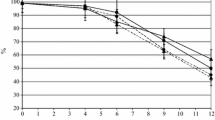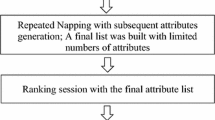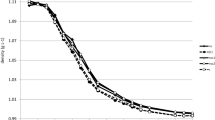Abstract
The practice of sequential fermentation of grape juice with a Saccharomyces cerevisiae starter strain coupled with a selected culture of a non-Saccharomyces yeast is used to improve the sensory profile and add complexity of wines. In this study, the effect of Torulaspora delbrueckii/S. cerevisiae sequential fermentation on Verdicchio wine under winery conditions was investigated, evaluating grape juices of three different vintages and two S. cerevisiae starter strains. In the 3 years of examination, some of oenological characters of the final wines were influenced by grape juices coming from different vintages. However, in all cases, T. delbrueckii/S. cerevisiae sequential fermentation influenced the analytical profiles of the Verdicchio wines according to the S. cerevisiae starter strain used. Indeed, different behaviours were found for the same T. delbrueckii strain together with the autochthonous Sc151 or the commercial VIN13 S. cerevisiae yeast, indicting that the yeast–yeast interaction plays an important role in analytical profile of wines. On the other hand, specific contributions were seen with T. delbrueckii, which is inoculated in sequential fermentation for three consecutive vintages using different starters.


Similar content being viewed by others
References
Ciani M, Comitini F (2011) Non-Saccharomyces wine yeasts have a promising role in biotechnological approaches to winemaking. Ann Microbiol 61:25–32
Comitini F, Gobbi M, Domizio P, Romani C, Lencioni L, Mannazzu I, Ciani M (2011) Selected non-Saccharomyces wine yeasts in controlled multistarter fermentations with Saccharomyces cerevisiae. Food Microbiol 28:873–888
Azzolini M, Tosi E, Lorenzini M, Finato F, Zapparoli G (2015) Contribution to the aroma of white wines by controlled Torulaspora delbrueckii cultures in association with Saccharomyces cereviasiae. World J Microbiol Biotechnol 31:277–293
Benito S, Morata A, Palomero F, Gonzalez MC, Suarez-Lepe JA (2011) Formation of vinylphenolic pyranoanthocyanins by Saccharomyces cerevisiae and Pichia guillermondii in red wines produced following different fermentation strategies. Food Chem 124:15–23
Contreras A, Hidalgo C, Henschke PA, Chambers PJ, Curtin C, Varela C (2014) Evaluation of non-Saccharomyces yeasts for the reduction of alcohol content in wine. Appl Environ Microbiol 80:1670–1678
Cordero Otero RR, Ubeda Iranzo JF, Briones Perez AI, Potgieter N, Arevalo Villena M, Pretorius IS, Van Rensburg P (2003) Characterization of the β-glucosidase activity produced by enological strain of non-Saccahromyces yeasts. J Food Sci 68:2564–2569
Garcia A, Carcel C, Dulau L, Samson A, Aguera E, Agosin E, Gunata Z (2002) Influence of a mixed culture with Debaryomyces vanriji and Saccharomyces cerevisiae on the volatiles of a Muscat wine. J Food Sci 67:1138–1143
Jolly NP, Varela C, Pretorius IS (2014) Not your ordinary yeast: non-Saccharomyces yeasts in wine production uncovered. FEMS Yeast Res 14:215–237
Morata A, Benito S, Loira I, Palomero F, Gonzalez MC, Suarez-Lepe JA (2012) Formation of pyranoanthocyanins by Schizosaccharomyces pombe during the fermentation of red must. Int J Food Microbiol 159:47–53
Quirós M, Rojas V, Gonzalez R, Morales P (2014) Selection of non-Saccharomyces yeast strains for reducing alcohol levels in wine by sugar respiration. Int J Food Microbiol 181:85–91
Sadoudi M, Tourdot-Marechal R, Rousseaux S, Steyer D, Gallardo-Chacon JJ, Ballester J, Vichi S, Guerin-Schneider R, Caixach J, Alexandre H (2012) Yeast-yeast interactions revealed by aromatic profile analysis of Sauvignon Blanc wine fermented by single or co-culture of non-Saccharomyces and Saccharomyces yeasts. Food Microbiol 32:243–253
Zott K, Thibon C, Bely M, Lonvaud-Funel A, Dubourdieu D, Masneuf-Pomarede I (2011) The grape must non-Saccharomyces microbial community: impact on volatile thiol release. Int J Food Microbiol 151:210–215
Gobbi M, Comitini F, Domizio P, Romani C, Lencioni L, Mannazzu I, Ciani M (2013) Lachancea thermotolerans and Saccharomyces cerevisiae in simultaneous and sequential co-fermentation: a strategy to enhance acidity and improve the overall quality of wine. Food Microbiol 33:271–281
Soden A, Francis IL, Oakey H, Henschke PA (2000) Effects of cofermentation with Candida stellata and Saccharomyces cerevisiae on the aroma and composition of Chardonnay wine. Aust J Grape Wine Res 6:21–30
Stringini M, Comitini F, Taccari M, Ciani M (2009) Yeast diversity during tapping and fermentation of palm wine from Cameroon. Food Microbiol 26:415–420
Bisson LF, Butzke CE (2000) Diagnosis and rectification of stuck and sluggish fermentations. Am J Enol Vitic 51:168–177
Dukes BC, Butzke CE (1998) Rapid determination of primary amino acids in grape juice using an o-phthaldialdehyde/N-acetyl-l-cysteine spectrophotometric assay. Am J Enol Vitic 49:125–134
Bely M, Stoeckle P, Masneuf-Pomarède I, Dubourdieu D (2008) Impact of mixed Torulaspora delbrueckii–Saccharomyces cerevisiae culture on high-sugar fermentation. Int J Food Microbiol 122:312–320
Ciani M, Maccarelli F (1998) Oenological properties of non-Saccharomyces yeasts associated with winemaking. World J Microbiol Biotechnol 14:199–203
Viana F, Gil JV, Genoves S, Valles S, Manzanares P (2008) Rational selection of non-Saccharomyces wine yeasts for mixed starters based on ester formation and enological traits. Food Microbiol 25:778–785
Azzolini M, Fedrizzi B, Tosi E, Finato F, Vagnoli P, Scrinzi C (2012) Effects of Torulaspora delbrueckii and Saccharomyces cerevisiae mixed cultures on fermentation and aroma of Amarone wine. Eur Food Res Technol 235:303–313
Loira I, Vejarano R, Bañuelos MA, Morata A, Tesfaye W, Uthurry C, Villa A, Cintora I, Suárez-Lepe JA (2014) Influence of sequential fermentation with Torulaspora delbrueckii and Saccharomyces cerevisiae on wine quality. LWT-Food Sci Technol 59:915–922
Ciani M, Comitini F (2015) Yeast interactions in multistarter wine fermentation. Curr Opin Food Sci 1:1–6
Capece A, Romaniello R, Siesto G, Pietrafesa R, Massari C, Poeta C, Romano P (2010) Selection of indigenous Saccharomyces cerevisiae strains for Nero d’Avola wine and evaluation of selected starter implantation in pilot fermentation. Int J Food Microbiol 144:187–192
Bokulich NA, Thorngate JH, Richardson PM, Mills DA (2014) Microbial biogeography of wine grapes is conditioned by cultivar, vintage, and climate. Proc Natl Acad Sci USA 111:139–148
Tofalo R, Perpetuini G, Fasoli G, Schirone M, Corsetti A, Suzzi G (2014) Biodiversity study of wine yeasts belonging to the “terroir” of Montepulciano d’Abruzzo “Colline Teramane” revealed Saccharomyces cerevisiae strains exhibiting atypical and unique 5.8S-ITS restriction patterns. Food Microbiol 39:7–12
Acknowledgments
The authors wish to thank the winery Terre Cortesi Moncaro s.r.c.l. for financial support as well as G. D’Ignazi, V. Durastanti, and T. Duca for their technical assistance.
Author information
Authors and Affiliations
Corresponding author
Ethics declarations
Conflict of interest
The authors declare that they have no conflict of interest.
Compliance with Ethic Requirements
This article does not contain any studies with human or animal subjects.
Rights and permissions
About this article
Cite this article
Canonico, L., Comitini, F. & Ciani, M. Influence of vintage and selected starter on Torulaspora delbrueckii/Saccharomyces cerevisiae sequential fermentation. Eur Food Res Technol 241, 827–833 (2015). https://doi.org/10.1007/s00217-015-2507-x
Received:
Revised:
Accepted:
Published:
Issue Date:
DOI: https://doi.org/10.1007/s00217-015-2507-x




